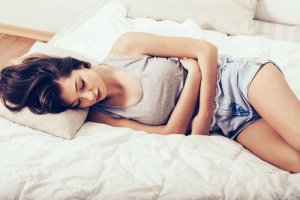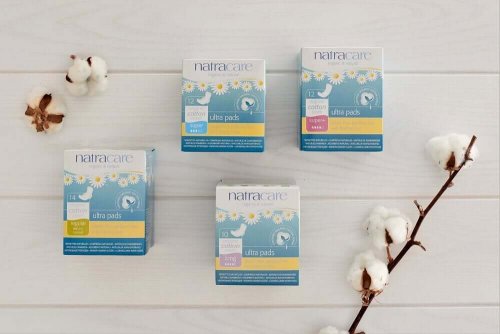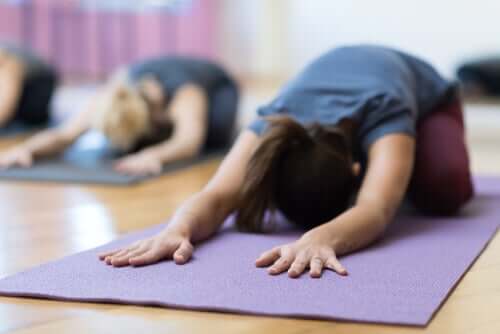Ten Ways to Relieve a Painful Period

A large number of women have experienced a painful period at least once in their lifetime. The pain and discomfort often go beyond common menstrual cramps, though. In fact, some women experience irritated genitals, followed by an itchy burning sensation and some of these symptoms may even be due to infections. Fortunately, there are many ways to prevent and treat this kind of pain.
Most of the time you can reduce this sort of discomfort and even relieve it by changing certain habits. You must consult a doctor if your pain is severe, though.
In this article, we’ll take a look at some of the common reasons for menstrual pain and what you can to do improve it.
Painful period and how to get relief
The typical menstrual discomfort is due to many factors. While you can’t control hormonal activity and the presence of certain diseases, you can take charge of your habits to relieve it.
1. Stay away from toxic intimate hygiene products.
Currently, there’s a wide variety of intimate hygiene products that aim to add comfort to your period.
However, many such conventional products, such as pads, panty protectors, and tampons, are made with plastic, conventional cotton (often sprayed with pesticides) and other chemicals that aren’t friendly to the vaginal microbiota.
The drawback is all of these are conducive to the accumulation of sweat, bacteria, and debris that eventually lead to a bad smell. Not to mention how much they irritate your skin, causing itching and other discomforts. Many of these products contain glyphosate, among others, and frequent contact with this chemical is a risk factor for diseases such as endometriosis and could eventually lead to infertility.
Luckily, there are many alternatives made with all-natural organic ingredients in the market. They’re made contain organic cotton, wood pulp, and vegetable starch. These companies carry a line of pads, panty protectors and organic breathable cotton tampons free of scents and dyes, among others.
Also, some of these intimate hygiene product lines have good market references. Women who’ve tried to claim that their use decreases the annoying itching, burning, and even some aspects of menstrual cramps. These claims have no scientific basis, but they’re worth keeping in mind.

2. Use products made of organic cotton.
Following up with the above, let’s highlight the importance of using organic products. Most of us use conventional products without really knowing what they’re made of. Also, it’s not in a company’s best interest to make you aware of the relationship between intimate hygiene products and vaginal discomfort.
In addition to the environmental impact it generates, the type of cotton that feminine hygiene items usually contain compromises a woman’s well-being. Its cultivation is on the list of most toxic in the world, as they use more pesticides in it than in any other crop. As you can see, products made of organic cotton claim to be free of these substances.
A study conducted in 2015 by researchers from Facultad de Ciencias Exactas of Universidad Nacional de La Plata found that 85% of the conventional products they analyzed contained glyphosate. This toxic chemical is present in Monsanto’s herbicide Roundup, commonly used on conventional cotton crops worldwide. There’s evidence that exposure to this chemical can lead to reproductive problems and diseases.
Also read: Mastalgia: Description and Causes
3. Stay away from aggressive chemicals.
The vagina is one of the most delicate areas of a woman’s body. Even though its varied microbiota guards against many infections, it can’t break down and eliminate the chemical substances they come into contact with it when we use certain products.
There are at least five ingredients in intimate hygiene products that are recognized as toxic.
- Plastic: This element, in addition to being a pollutant, promotes a sweaty environment that leads to unpleasant odors, irritation, and infections.
- Dioxins: This is a chemical that results from bleaching cotton with chlorine. Its exposure has been linked to hormonal problems and it may cause fertility problems, according to a detailed report of the World Health Organization (WHO).
- Super absorbent polymers (SAP): These are petroleum derivates that can cause irritation and foul smells.
- Pesticides: These are toxic chemicals used for spraying cotton crops.
- Dyes: These are completely unnecessary and often lead to alterations of the vaginal microbiota, resulting in irritations and an increased risk of infection.
So, how can you avoid these chemicals for a less painful, annoying menstruation? It’s simply a matter of learning to be selective. There are many organic products to help with monthly periods.
4. Improving your diet can help relieve a painful period.
Adjusting your dietary habits is very important when it comes to reducing menstrual pain. According to a study published in the Obstetrics and Gynecology medical journal, a diet rich in vegetables and low in fat can reduce the intensity of PMS and dysmenorrhea (menstrual cramps).

5. Try heat therapy.
Heat therapy has been a treatment for a less painful period for many years. Research published in Evidence-Based Nursing found that heat is as effective as ibuprofen when it comes to menstrual cramps. This is because it reduces swelling and induces relaxation.
6. Take anti-inflammatory infusions for relieving a painful period.
These are a natural therapeutic option against menstrual discomforts. In fact, a review in the Iranian Journal of Pharmaceutical Research determined that herbal medicine is a promising way to relieve dysmenorrhea. Use chamomile, ginger, cinnamon, or mint.
Do not miss: Chamomile and Parsley Remedy for an Absence of Menstruation
7. Exercise regularly.
Stay active throughout your menstrual cycle. This is because physical activity promotes the release of endorphins, also known as “wellness hormones.” Thus, 20 minutes of regular exercise per day can help relieve your menstrual pain and therefore improve your mood.
8. Practice relaxation techniques.
Spend some time practicing meditation, yoga or any other form of relaxation as all of these can contribute to the relief menstrual discomfort. Not only will it positively impact your mood, but it’ll also help you relieve vaginal pain and discomfort.

9. Don’t self-medicate.
Many over-the-counter pain relievers help relieve menstrual cramps. However, be careful not to exceed their consumption. In fact, consult your doctor or pharmacist about the appropriate doses. As for other symptoms such as itching and irritation, you must know their origin before determining appropriate treatment.
10. Consult a doctor if you have a painful period.
Menstruation is naturally a little bit uncomfortable and painful to some extent. However, you might want to talk to your doctor if your symptoms are severe and persistent. Occasionally, cramps, irritation, burning, and bad odors could require specific treatment. Thus, you may need some additional tests to determine this.
A painful period: conclusion
In short, pay more attention to the intimate hygiene products you use and opt for organic alternatives free of irritating or harmful substances. You should also review your life habits and consult a doctor.
All cited sources were thoroughly reviewed by our team to ensure their quality, reliability, currency, and validity. The bibliography of this article was considered reliable and of academic or scientific accuracy.
- Nicole W. A question for women’s health: chemicals in feminine hygiene products and personal lubricants. Environ Health Perspect. 2014;122(3):A70–A75. doi:10.1289/ehp.122-A70
- Fashemi B, Delaney ML, Onderdonk AB, Fichorova RN. Effects of feminine hygiene products on the vaginal mucosal biome. Microb Ecol Health Dis. 2013;24:10.3402/mehd.v24i0.19703. Published 2013 Feb 25. doi:10.3402/mehd.v24i0.19703
- Barnard, N. D., Scialli, A. R., Hurlock, D., & Bertron, P. (2000). Diet and sex-hormone binding globulin, dysmenorrhea, and premenstrual symptoms. Obstetrics and Gynecology. https://doi.org/10.1016/S0029-7844(99)00525-6
- Akin, M. D., Weingand, K. W., Hengehold, D. A., Goodale, M. B., Hinkle, R. T., & Smith, R. P. (2001). Continuous low-level topical heat in the treatment of dysmenorrhea. Obstetrics and Gynecology. https://doi.org/10.1016/S0029-7844(00)01163-7
- Safarzadeh, A., Zare, S., Yousefabadi, S. R., & Ghoreishinia, G. (2016). The relationship between Exercise and premenstrual syndrome. International Journal of Medical Research & Health Sciences.
- Jasuja, Veena. (2013). Relaxation Technique and Premenstual Syndrome: A Psychophysiological Study.. IOSR Journal of Dental and Medical Sciences. 8. 17-22. 10.9790/0853-0811722.
This text is provided for informational purposes only and does not replace consultation with a professional. If in doubt, consult your specialist.








